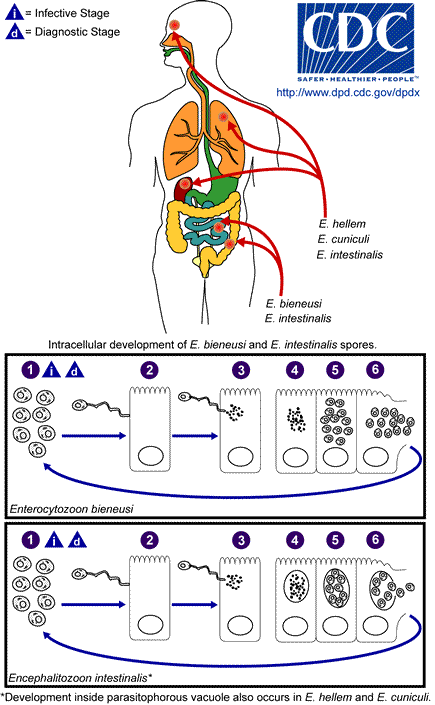| |
The infective form of
microsporidia is the resistant spore and it can survive for a long time in
the environment
 . The spore
extrudes its polar tubule and infects the host cell . The spore
extrudes its polar tubule and infects the host cell
 . The spore
injects the infective sporoplasm into the eukaryotic host cell through the
polar tubule . The spore
injects the infective sporoplasm into the eukaryotic host cell through the
polar tubule
 . Inside the
cell, the sporoplasm undergoes extensive multiplication either by merogony
(binary fission) or schizogony (multiple fission) . Inside the
cell, the sporoplasm undergoes extensive multiplication either by merogony
(binary fission) or schizogony (multiple fission)
 . This
development can occur either in direct contact with the host cell cytoplasm
(e.g., E. bieneusi) or inside a vacuole termed parasitophorous
vacuole (e.g., E. intestinalis). Either free in the cytoplasm or
inside a parasitophorous vacuole, microsporidia develop by sporogony to
mature spores . This
development can occur either in direct contact with the host cell cytoplasm
(e.g., E. bieneusi) or inside a vacuole termed parasitophorous
vacuole (e.g., E. intestinalis). Either free in the cytoplasm or
inside a parasitophorous vacuole, microsporidia develop by sporogony to
mature spores
 . During
sporogony, a thick wall is formed around the spore, which provides
resistance to adverse environmental conditions. When the spores increase in
number and completely fill the host cell cytoplasm, the cell membrane is
disrupted and releases the spores to the surroundings . During
sporogony, a thick wall is formed around the spore, which provides
resistance to adverse environmental conditions. When the spores increase in
number and completely fill the host cell cytoplasm, the cell membrane is
disrupted and releases the spores to the surroundings
 . These free
mature spores can infect new cells thus continuing the cycle. . These free
mature spores can infect new cells thus continuing the cycle. |
|
